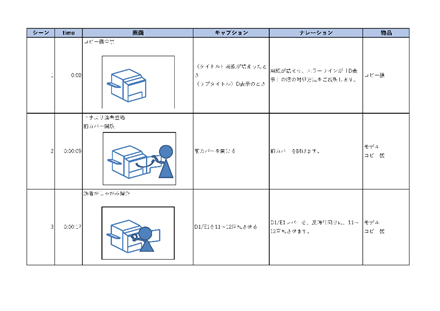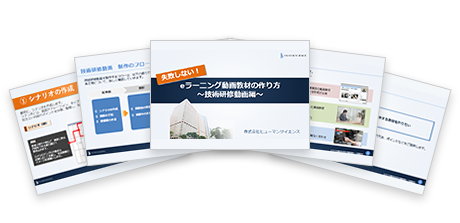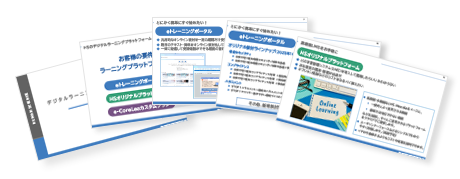2020.10.26
Common Issues with Converting Technical Training into Video Materials
Skills required for construction are typically developed and honed through practical training, on-the-job training, and experience on site. For experienced veterans who have acquired sufficient skills, they are indispensable not only on the actual site, but also in guiding successors.
At one of our client's sites, we were told that even if one has sufficient knowledge, it is a separate issue whether they can actually put their hands to work. This also shows that technical skills are literally "acquired" and can be considered important.
On the other hand, many companies are facing the urgent challenge of inheriting technical skills due to the recent labor shortage and the simultaneous retirement of the veteran generation that has supported them.
Therefore, here, we will explain the points to keep in mind when using videos to preserve the technical training with practical skills that have been conducted in group training up until now, as a means of passing on technical knowledge.

Table of Contents
Common Issues with Converting Technical Training into Video Materials
- Knowledge is personalized and not documented in materials
- Technicians may not be following the best practices
- High level of expertise makes it difficult to generalize and simplify
Measures for Problem Solving
- Extracting Necessary Information
- Organizing and Rebuilding Information
- Capturing and Editing Thoroughly
Common Issues with Converting Technical Training into Video Materials
Based on our past development experience and the concerns we have heard from our clients, the following are the most common obstacles to creating educational materials:
- - Knowledge is personalized and not summarized in documents
- ・There is a possibility that the technician is not working in an exemplary manner
- - High level of expertise, difficult to generalize and simplify
Let's take a look at each one.
Expertise is personalized and not summarized in documents.
The expertise of veteran technicians is something that is only cultivated through years of experience, so it seems that there are rarely any systematic textbooks or explanatory materials available. However, in order to create teaching materials, it is necessary to extract and organize the knowledge and skills that are unique to technicians and tailor them into teaching materials.
There is a possibility that the technician is not working in an exemplary manner.
As a veteran technician, there is a possibility that due to years of experience, the behavior may not be faithful to the basics. It is precisely because they are veterans that they can still perform well even with some shortcuts.
However, in videos, veteran technicians must be the subject and demonstrate exemplary and faithful work to the basics. Therefore, there is a concern that if the correctness of the behavior cannot be fully checked, the resulting material may be insufficient as a teaching material.
Highly specialized and difficult to generalize or simplify
In construction, specialized terminology, various tools, and materials are often used. In addition, the behavior of workers can be complex and difficult to understand. It is important to convey these things as accurately as possible to viewers of the video.
In a group training setting, it is possible to ask questions and get closer to the action, or view it from different angles. However, in the case of a video, if care is not taken during filming or editing, it may end without being easily understood by viewers.

Measures for Problem Solving
In the three "common problems" mentioned earlier, the issue lies in the "gap" between the advanced expertise of experienced technicians and the level of understanding of learners.
The key to solving this problem is determining who will bridge this gap and how it will be overcome.
It would be ideal if experienced technicians, who are also a source of information for teaching materials, could be responsible for planning and creating scenarios for teaching materials. However, this idea is not realistic. Experienced technicians are not experts in teaching materials or lectures. In addition, if the burden of materialization increases, it may impede their original duties.
Many companies seem to be struggling with this part and are having trouble turning it into educational material.
The following measures are necessary to complete the "video that can be used as teaching material" while solving this problem.
- ・Extract necessary information
- ・Organize and reconstruct information
- ・Capture all footage and edit appropriately
We will explain in order.
Retrieve necessary information
The necessary information lies within the experienced technicians who will become the subject. In order to incorporate it into the teaching materials, it is necessary to extract it.
There are two possible responses here.
- ・Conduct rehearsal of work
- - Conduct detailed interviews with technical experts
Rehearsals are effective for confirming procedures with technicians and confirming the setup for filming.
By confirming in advance what actions will be taken and where, it is possible to prepare tools and materials without excess or shortage, and to have an idea of the camera angles.
Filming without rehearsal can lead to problems with the setup and multiple takes that are not usable.
The following are the items that should be discussed with the technical staff.
- ・Purpose and goal of the task
- ・Procedure
- ・Preparation (Tools, Materials, Equipment)
- ・Key Points and Notes for the Task
We will first conduct a hearing and then proceed to the rehearsal. During the rehearsal, we will confirm any doubts or unclear points on the spot.
After the rehearsal, we will organize the work procedures and finished image in the form of a "scenario". This is the image of gathering the necessary information through hearing in order to create a scenario.
We will record all information such as how to use tools and safety points, and reflect them in the video editing process afterwards.
There are various benefits to closely communicating with technical experts.
By asking questions, you can extract important information that may not immediately come to mind for the experts, such as key points for teaching materials.
Information that exists only in the minds of technical experts can become concrete through conversation. In the process, you may also notice overlooked points or realize that something is deviating from the basics.
Organize and rebuild information
We classify and organize information obtained through rehearsals and hearings, and create a scenario. The scenario is not just created here, but is continuously refined throughout the entire process until the video is completed.
The scenario includes the following content. At the pre-shooting stage, everything is provisional and hypothetical.
- ・Image: What kind of screen to create (storyboard)
- ・Caption (Notes, Terminology, Supplementary Explanation)
- ・Narration)
A caption is a descriptive text or name displayed on the screen.
Creating captions while considering which information goes where can also help identify any missing or conflicting information. Any questions, additional information, or corrections raised at this point should ideally be addressed beforehand, or during the filming if time is limited.

Scenario (Example)
Capture thoroughly and edit appropriately
It's finally time for filming. Let's list the necessary staff and roles for filming. If there are plenty of staff, filming will proceed smoothly to some extent, but it is a good idea to adjust according to budget and individual schedule conditions.
In addition, it is not uncommon for one person to take on multiple roles, such as combining the roles of director and cameraman, or having the cameraman assistant also serve as assistant director.
| Name | Role | Necessity |
|---|---|---|
| Director | Chief photographer. While checking the scenario, confirm the quality of the video, including camera angles, and make a decision of OK/NG. | Required |
| Photographer | Perform shooting. The number of people required is equal to the number of cameras. | Required |
| Camera Assistant | When taking photos involving camera movement, perform tasks such as pulling cables. We also handle miscellaneous tasks such as lens and battery replacement. | |
| Voice | Necessary when recording audio (narration or interview audio) on the spot. Check volume and sound quality, and manage the microphone. | Required at the time of recording |
| Lighting | Responsible for managing lighting technology and lighting equipment | |
| Assistant Director | Undertakes general miscellaneous tasks related to photography |
We will conduct the shooting according to the scenario. During this process, we will confirm whether the actions are truly exemplary and faithful to the basics, and whether they match the information we have heard.
We will also conduct appropriate hearings during the shooting, and confirm any issues on the spot, and pay attention to ensure that there are no missed shots.
In addition, if there are any actions that are complex or difficult, we will shoot them from different angles or take additional shots to show the details, in order to capture all necessary scenes.
After shooting, the scenario will be reorganized.
We will reflect the information collected during shooting and create a storyboard that envisions the completed form of the video material. We will also come up with captions (explanatory text or names displayed on the screen) and narration. The scenario will be shared with technical experts to confirm the accuracy of the language and supplement any missing information.
After shooting, we will proceed with video editing. Based on the scenario, we will go through the flow of rough editing, checking, and narration recording to complete the video.
We will also share the edited video with technical experts and proceed while confirming that the content is correct.
Author:
Shizuko Sase
Education Solutions Department Production Group Writer
After joining Human Science, worked as a Technical Writer,
experienced in designing and writing product manuals and operation manuals.
Subsequently, engaged in writing and directing e-learning material manuscripts.
Involved in the production of approximately 200 educational materials so far.
Contact Us:
Phone Number: 03-5321-3111
hsweb_inquiry@science.co.jp
No Failure! How to Create e-Learning Video Materials
~Technical Training Video Edition~
We will explain the features and creation methods of technical training videos in e-learning video materials. We also include common points in video production.

【Content】
Technical Training Video Production Flow
1. Preparations (① Scenario Creation, ② Shooting Arrangements, ③ Storyboard Creation)
2. Shooting Day (① Pre-Shooting Preparations, ② Shooting Tasks)
3. Editing Work (① Editing, ② Encoding)
Latest Blog
- 2024.04.02
- English Learning Using Moodle and ChatGPT












